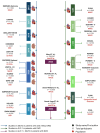A decade of progress in type 2 diabetes and cardiovascular disease: advances in SGLT2 inhibitors and GLP-1 receptor agonists - a comprehensive review
- PMID: 40692593
- PMCID: PMC12277171
- DOI: 10.3389/fendo.2025.1605746
A decade of progress in type 2 diabetes and cardiovascular disease: advances in SGLT2 inhibitors and GLP-1 receptor agonists - a comprehensive review
Erratum in
-
Correction: A decade of progress in type 2 diabetes and cardiovascular disease: advances in SGLT2 inhibitors and GLP-1 receptor agonists - a comprehensive review.Front Endocrinol (Lausanne). 2025 Aug 20;16:1663787. doi: 10.3389/fendo.2025.1663787. eCollection 2025. Front Endocrinol (Lausanne). 2025. PMID: 40909226 Free PMC article.
Abstract
Cardiovascular and renal complications remain leading causes of morbidity and mortality among individuals with type 2 diabetes mellitus (T2DM). Since 2015, large-scale cardiovascular outcome trials (CVOTs) have demonstrated that sodium-glucose cotransporter-2 inhibitors (SGLT2i) and glucagon-like peptide-1 receptor agonists (GLP-1 RAs) significantly reduce the risk of major adverse cardiovascular events, cardiovascular mortality, and heart failure hospitalization in patients with T2DM and established cardiovascular disease or high-risk profiles. These findings-originating from landmark trials such as EMPA-REG OUTCOME, LEADER, and SUSTAIN-6-have led to substantial revisions in international guidelines from the European Society of Cardiology, American College of Cardiology, and American Heart Association, which now recommend the use of SGLT2i or GLP-1 RAs, often in conjunction with metformin. SGLT2i have shown robust effects in reducing heart failure hospitalization and slowing the progression of chronic kidney disease, while GLP-1 RAs have demonstrated superior efficacy in reducing atherothrombotic events, particularly non-fatal stroke. Additionally, emerging data supports the complementary use of both drug classes, revealing additive benefits on cardiovascular and renal outcomes without increased toxicity. This narrative review summarizes the mechanisms of action, clinical efficacy, safety profiles, and sex-specific outcomes associated with SGLT2i and GLP-1 RAs. It also highlights key evidence supporting their combined use and underscores their critical role in optimizing long-term outcomes in patients with T2DM and cardiovascular disease.
Keywords: GLP-1 agonists; SGLT2 inhibitors; cardiovascular outcomes; combination therapy; heart failure; renal outcomes.
Copyright © 2025 Aristizábal-Colorado, Corredor-Rengifo, Sierra-Castillo, López-Corredor, Vernaza-Trujillo, Weir-Restrepo, Izquierdo-Condoy, Ortiz-Prado, Rico-Fontalvo, Gómez-Mesa, Abreu-Lomba and Rivera-Martínez.
Conflict of interest statement
JR-F declares that he has received honoraria for lectures for AstraZeneca, Boehringer Ingelheim, Novo Nordisk, Lilly, Sanofi, Novartis, Abbvie, Merck, and Bayer. He has participated in Advisory Board with AstraZeneca, Boehringer Ingelheim, Bayer, and Novo Nordisk. J-EG-M declares that he has received honoraria for lectures for AstraZeneca, Bayer, Boheringer Ingelheim, Merck, and Xinetixs Pharma. He has participated in Advisory Board with AstraZeneca, and Boheringer Ingelheim. The remaining authors declare that the research was conducted in the absence of any commercial or financial relationships that could be construed as a potential conflict of interest.
Figures

Similar articles
-
Dipeptidyl peptidase-4 inhibitors, glucagon-like peptide 1 receptor agonists and sodium-glucose co-transporter-2 inhibitors for people with cardiovascular disease: a network meta-analysis.Cochrane Database Syst Rev. 2021 Oct 25;10(10):CD013650. doi: 10.1002/14651858.CD013650.pub2. Cochrane Database Syst Rev. 2021. PMID: 34693515 Free PMC article.
-
The evolution of type 2 diabetes management: glycemic control and beyond with SGLT-2 inhibitors and GLP-1 receptor agonists.J Osteopath Med. 2023 Nov 3;124(3):127-135. doi: 10.1515/jom-2023-0179. eCollection 2024 Mar 1. J Osteopath Med. 2023. PMID: 37921061 Review.
-
Glucagon-like peptide 1 (GLP-1) receptor agonists for people with chronic kidney disease and diabetes.Cochrane Database Syst Rev. 2025 Feb 18;2(2):CD015849. doi: 10.1002/14651858.CD015849.pub2. Cochrane Database Syst Rev. 2025. PMID: 39963952
-
Sodium-glucose cotransporter protein-2 (SGLT-2) inhibitors and glucagon-like peptide-1 (GLP-1) receptor agonists for type 2 diabetes: systematic review and network meta-analysis of randomised controlled trials.BMJ. 2021 Jan 13;372:m4573. doi: 10.1136/bmj.m4573. BMJ. 2021. PMID: 33441402 Free PMC article.
-
Comparative Effectiveness of Glucagon-Like Peptide-1 Receptor Agonists and Sodium/Glucose Cotransporter 2 Inhibitors in Preventing Chronic Kidney Failure and Mortality in Patients With Type 2 Diabetes and CKD.Am J Kidney Dis. 2025 Sep;86(3):301-313.e1. doi: 10.1053/j.ajkd.2025.03.016. Epub 2025 Apr 29. Am J Kidney Dis. 2025. PMID: 40311668
References
-
- Vos T, Lim SS, Abbafati C, Abbas KM, Abbasi M, Abbasifard M, et al. Global burden of 369 diseases and injuries in 204 countries and territories, 1990–2019: a systematic analysis for the Global Burden of Disease Study 2019. Lancet. (2020) 396:1204–22. doi: 10.1016/S0140-6736(20)30925-9, PMID: - DOI - PMC - PubMed
Publication types
MeSH terms
Substances
LinkOut - more resources
Full Text Sources
Medical

